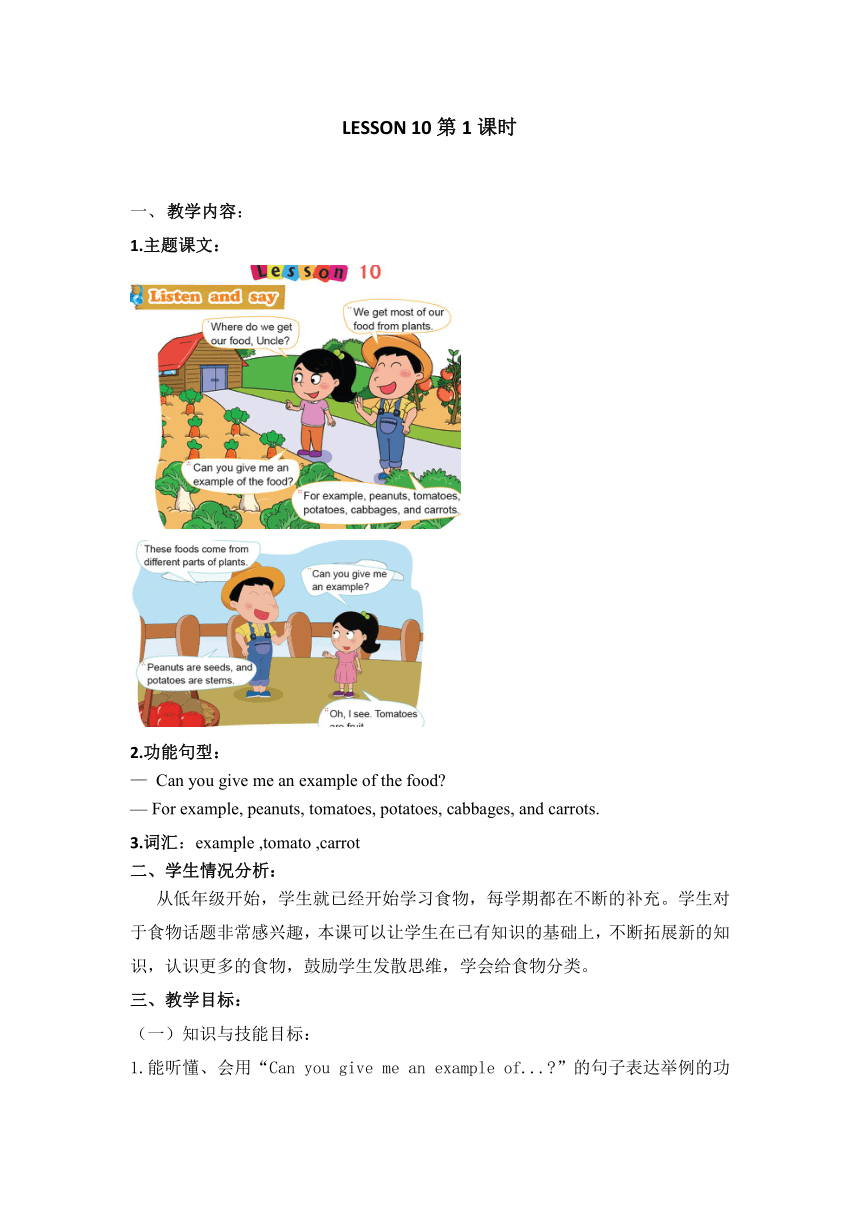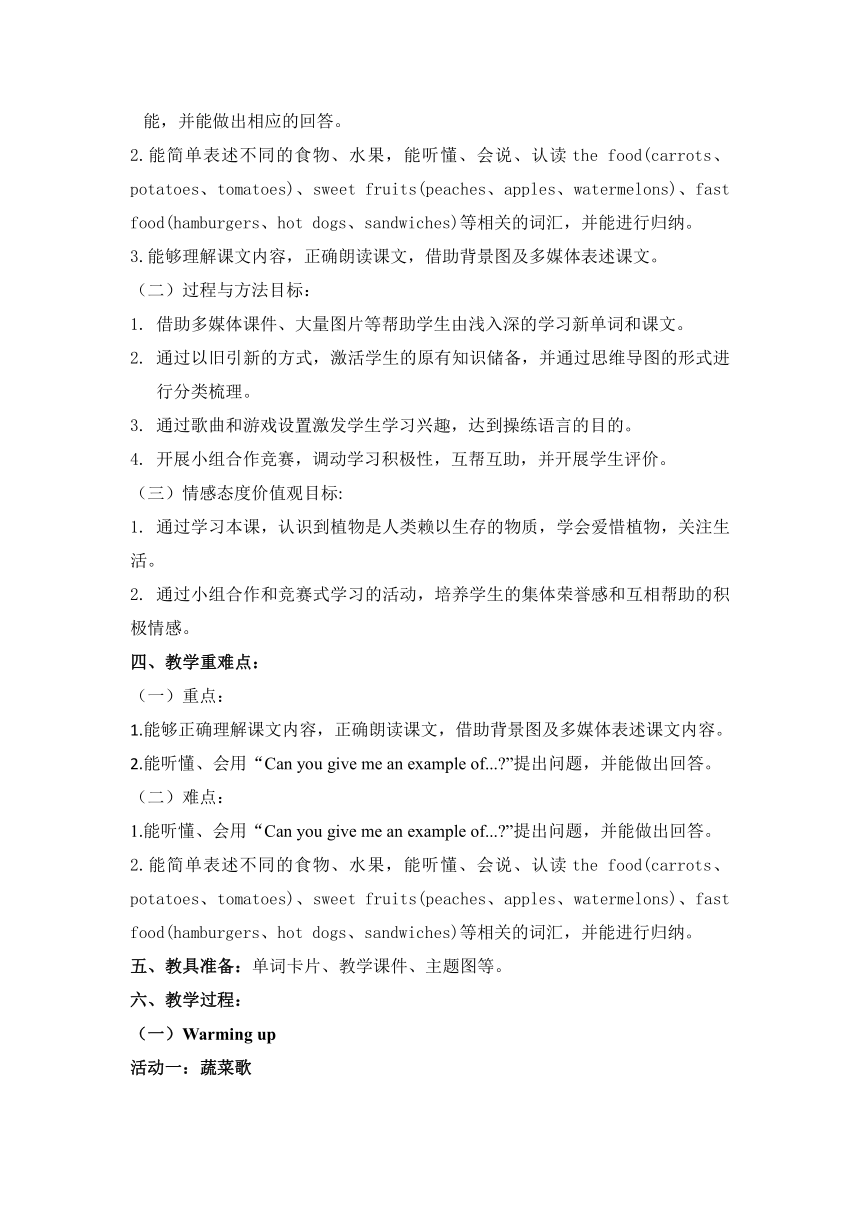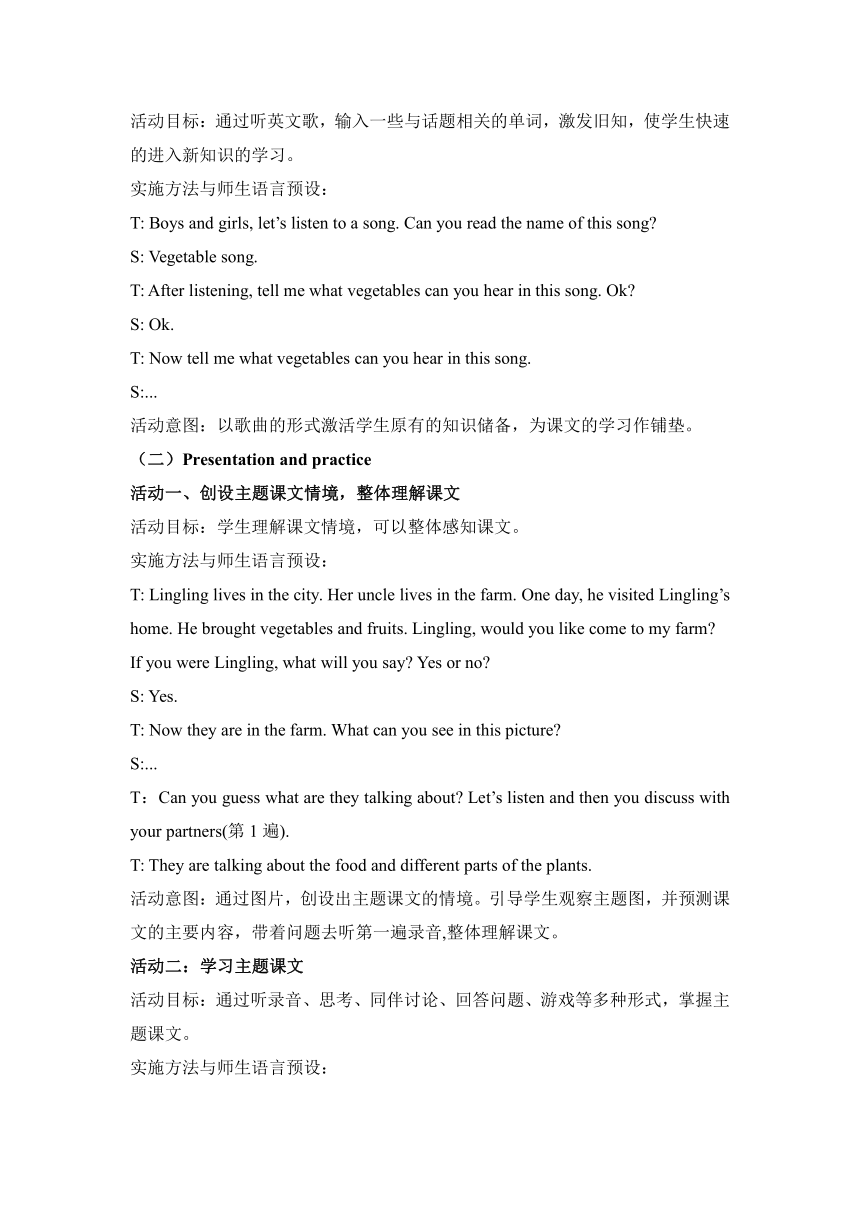Unit 3 How are you? Lesson 10教案
文档属性
| 名称 | Unit 3 How are you? Lesson 10教案 |  | |
| 格式 | doc | ||
| 文件大小 | 500.5KB | ||
| 资源类型 | 教案 | ||
| 版本资源 | 北京版 | ||
| 科目 | 英语 | ||
| 更新时间 | 2021-11-14 21:49:05 | ||
图片预览



文档简介
LESSON 10第1课时
一、 教学内容:
1.主题课文:
2.功能句型:
— Can you give me an example of the food
— For example, peanuts, tomatoes, potatoes, cabbages, and carrots.
3.词汇:example ,tomato ,carrot
二、学生情况分析:
从低年级开始,学生就已经开始学习食物,每学期都在不断的补充。学生对于食物话题非常感兴趣,本课可以让学生在已有知识的基础上,不断拓展新的知识,认识更多的食物,鼓励学生发散思维,学会给食物分类。
三、教学目标:
(一)知识与技能目标:
1.能听懂、会用“Can you give me an example of... ”的句子表达举例的功能,并能做出相应的回答。
2.能简单表述不同的食物、水果,能听懂、会说、认读the food(carrots、potatoes、tomatoes)、sweet fruits(peaches、apples、watermelons)、fast food(hamburgers、hot dogs、sandwiches)等相关的词汇,并能进行归纳。
3.能够理解课文内容,正确朗读课文,借助背景图及多媒体表述课文。
(二)过程与方法目标:
1. 借助多媒体课件、大量图片等帮助学生由浅入深的学习新单词和课文。
2. 通过以旧引新的方式,激活学生的原有知识储备,并通过思维导图的形式进行分类梳理。
3. 通过歌曲和游戏设置激发学生学习兴趣,达到操练语言的目的。
4. 开展小组合作竞赛,调动学习积极性,互帮互助,并开展学生评价。
(三)情感态度价值观目标:
1. 通过学习本课,认识到植物是人类赖以生存的物质,学会爱惜植物,关注生活。
2. 通过小组合作和竞赛式学习的活动,培养学生的集体荣誉感和互相帮助的积极情感。
四、教学重难点:
(一)重点:
1.能够正确理解课文内容,正确朗读课文,借助背景图及多媒体表述课文内容。
2.能听懂、会用“Can you give me an example of... ”提出问题,并能做出回答。
(二)难点:
1.能听懂、会用“Can you give me an example of... ”提出问题,并能做出回答。
2.能简单表述不同的食物、水果,能听懂、会说、认读the food(carrots、potatoes、tomatoes)、sweet fruits(peaches、apples、watermelons)、fast food(hamburgers、hot dogs、sandwiches)等相关的词汇,并能进行归纳。
五、教具准备:单词卡片、教学课件、主题图等。
六、教学过程:
(一)Warming up
活动一:蔬菜歌
活动目标:通过听英文歌,输入一些与话题相关的单词,激发旧知,使学生快速的进入新知识的学习。
实施方法与师生语言预设:
T: Boys and girls, let’s listen to a song. Can you read the name of this song
S: Vegetable song.
T: After listening, tell me what vegetables can you hear in this song. Ok
S: Ok.
T: Now tell me what vegetables can you hear in this song.
S:...
活动意图:以歌曲的形式激活学生原有的知识储备,为课文的学习作铺垫。
(二)Presentation and practice
活动一、创设主题课文情境,整体理解课文
活动目标:学生理解课文情境,可以整体感知课文。
实施方法与师生语言预设:
T: Lingling lives in the city. Her uncle lives in the farm. One day, he visited Lingling’s home. He brought vegetables and fruits. Lingling, would you like come to my farm
If you were Lingling, what will you say Yes or no
S: Yes.
T: Now they are in the farm. What can you see in this picture
S:...
T:Can you guess what are they talking about Let’s listen and then you discuss with your partners(第1遍).
T: They are talking about the food and different parts of the plants.
活动意图:通过图片,创设出主题课文的情境。引导学生观察主题图,并预测课文的主要内容,带着问题去听第一遍录音,整体理解课文。
活动二:学习主题课文
活动目标:通过听录音、思考、同伴讨论、回答问题、游戏等多种形式,掌握主题课文。
实施方法与师生语言预设:
1、听录音回答问题(第2遍),学习主题课文一
T: There are three tasks on your learning sheet. Let’s listen again then you finish task1 and 2.
S: Where do we get our food
S: What food can you hear
T: Now I have two questions. You can answer the questions refer to your learning sheet. Question 1.
S: We get most of our food from plants.
T: There are two parts in the picture. One is bigger. One is smaller. The bigger parts are from plants, the smaller parts are from animals. So we say, we get most of our food from plants. Can you guess the meaning of most of
S: ....
T: Question 2.
S: Carrots、potatoes、tomatoes、cabbages and peanuts.(板书)
T:Pay attention to s, es.
Ss read after teacher.
2、游戏:What’s missing
3、听录音回答问题(第3遍),学习主题课文二
T:Look at this picture. There are some vegetables in the basket. Can you guess what happened
S: Maybe they pick up the vegetables together.
T: Yes, and they are having a rest now. Let’s listen and then you finish task3.
Ss:Ok
T: Let’s check the answers. What are they
S:tomatoes、peanuts、potatoes、seeds、fruits、stems
T: What’s the English for the different parts of a plant
S: They are the roots.....
T: Tomatoes are fruits. Potatoes are stems. Peanuts are seeds.
活动意图:学生可以正确理解课文内容
活动三:练习主题课文
活动目标:通过练习,学生可以较熟练的朗读课文。
1.跟读
T:Now boys and girls, open your books. let’s listen and repeat.
Ss follow tape to read.
2. 同伴练习
T:You can practice with your partners. One is Lingling and one is her uncle.
Ss practice with partners.
3. 展示及评价
T: Who wants to come to the front
活动意图:通过多种方法练习,使学生能够较熟练的朗读课文。
(三)Production
活动一:食物分类
活动目标:能简单表述不同的食物、水果,能听懂、会说、认读the food(carrots、potatoes、tomatoes)、sweet fruits(peaches、apples、watermelons)、fast food(hamburgers、hot dogs、sandwiches)等相关的词汇,并能进行归纳。
实施方法与师生语言预设:
T: We have learned many foods. For example, vegetables are food. Sweet fruits are food. Fast food are food. Can you give me some examples You can discuss with your partners.
Ss discuss.
T: Can you give me an example of vegetables
S: For example,....
T: Can you give me an example of sweet fruits
S: For example,....
T: Can you give me an example of fast food
S: For example,....
活动意图:通过讨论和总结梳理,激发学生旧知,并能简单表述不同的食物、水果,能听懂、会说、认读the food(carrots、potatoes、tomatoes)、sweet fruits(peaches、apples、watermelons)、fast food(hamburgers、hot dogs、sandwiches)等相关的词汇,并能进行归纳。
活动二:游戏Good memory
活动目标:能听懂、会用“Can you give me an example of... ”提出问题,并能做出回答。
实施方法与师生语言预设:
T:Now let’s play a game called good memory. Four students in a group. S1 ask. S2 gives one example and asks S3. S3 gives two examples and asks S4. S4 gives three examples and ask S1. S1 gives four examples. Everyone needs to remember others’ examples and give a new example.
活动意图:通过小组合作的方式完成游戏,能听懂、会用“Can you give me an example of... ”提出问题,并能做出回答。
(4)总结
T: We have learned plants and food. After class, you can go to the park or farm with your parents, and try to know more about the plants and food.
(五)Homework
1. 一起作业网
2. 书写四会单词和功能句。
七、板书设计
八、课后反思
Lesson 10
Can you give me an example of...
For example...
Mind map
一、 教学内容:
1.主题课文:
2.功能句型:
— Can you give me an example of the food
— For example, peanuts, tomatoes, potatoes, cabbages, and carrots.
3.词汇:example ,tomato ,carrot
二、学生情况分析:
从低年级开始,学生就已经开始学习食物,每学期都在不断的补充。学生对于食物话题非常感兴趣,本课可以让学生在已有知识的基础上,不断拓展新的知识,认识更多的食物,鼓励学生发散思维,学会给食物分类。
三、教学目标:
(一)知识与技能目标:
1.能听懂、会用“Can you give me an example of... ”的句子表达举例的功能,并能做出相应的回答。
2.能简单表述不同的食物、水果,能听懂、会说、认读the food(carrots、potatoes、tomatoes)、sweet fruits(peaches、apples、watermelons)、fast food(hamburgers、hot dogs、sandwiches)等相关的词汇,并能进行归纳。
3.能够理解课文内容,正确朗读课文,借助背景图及多媒体表述课文。
(二)过程与方法目标:
1. 借助多媒体课件、大量图片等帮助学生由浅入深的学习新单词和课文。
2. 通过以旧引新的方式,激活学生的原有知识储备,并通过思维导图的形式进行分类梳理。
3. 通过歌曲和游戏设置激发学生学习兴趣,达到操练语言的目的。
4. 开展小组合作竞赛,调动学习积极性,互帮互助,并开展学生评价。
(三)情感态度价值观目标:
1. 通过学习本课,认识到植物是人类赖以生存的物质,学会爱惜植物,关注生活。
2. 通过小组合作和竞赛式学习的活动,培养学生的集体荣誉感和互相帮助的积极情感。
四、教学重难点:
(一)重点:
1.能够正确理解课文内容,正确朗读课文,借助背景图及多媒体表述课文内容。
2.能听懂、会用“Can you give me an example of... ”提出问题,并能做出回答。
(二)难点:
1.能听懂、会用“Can you give me an example of... ”提出问题,并能做出回答。
2.能简单表述不同的食物、水果,能听懂、会说、认读the food(carrots、potatoes、tomatoes)、sweet fruits(peaches、apples、watermelons)、fast food(hamburgers、hot dogs、sandwiches)等相关的词汇,并能进行归纳。
五、教具准备:单词卡片、教学课件、主题图等。
六、教学过程:
(一)Warming up
活动一:蔬菜歌
活动目标:通过听英文歌,输入一些与话题相关的单词,激发旧知,使学生快速的进入新知识的学习。
实施方法与师生语言预设:
T: Boys and girls, let’s listen to a song. Can you read the name of this song
S: Vegetable song.
T: After listening, tell me what vegetables can you hear in this song. Ok
S: Ok.
T: Now tell me what vegetables can you hear in this song.
S:...
活动意图:以歌曲的形式激活学生原有的知识储备,为课文的学习作铺垫。
(二)Presentation and practice
活动一、创设主题课文情境,整体理解课文
活动目标:学生理解课文情境,可以整体感知课文。
实施方法与师生语言预设:
T: Lingling lives in the city. Her uncle lives in the farm. One day, he visited Lingling’s home. He brought vegetables and fruits. Lingling, would you like come to my farm
If you were Lingling, what will you say Yes or no
S: Yes.
T: Now they are in the farm. What can you see in this picture
S:...
T:Can you guess what are they talking about Let’s listen and then you discuss with your partners(第1遍).
T: They are talking about the food and different parts of the plants.
活动意图:通过图片,创设出主题课文的情境。引导学生观察主题图,并预测课文的主要内容,带着问题去听第一遍录音,整体理解课文。
活动二:学习主题课文
活动目标:通过听录音、思考、同伴讨论、回答问题、游戏等多种形式,掌握主题课文。
实施方法与师生语言预设:
1、听录音回答问题(第2遍),学习主题课文一
T: There are three tasks on your learning sheet. Let’s listen again then you finish task1 and 2.
S: Where do we get our food
S: What food can you hear
T: Now I have two questions. You can answer the questions refer to your learning sheet. Question 1.
S: We get most of our food from plants.
T: There are two parts in the picture. One is bigger. One is smaller. The bigger parts are from plants, the smaller parts are from animals. So we say, we get most of our food from plants. Can you guess the meaning of most of
S: ....
T: Question 2.
S: Carrots、potatoes、tomatoes、cabbages and peanuts.(板书)
T:Pay attention to s, es.
Ss read after teacher.
2、游戏:What’s missing
3、听录音回答问题(第3遍),学习主题课文二
T:Look at this picture. There are some vegetables in the basket. Can you guess what happened
S: Maybe they pick up the vegetables together.
T: Yes, and they are having a rest now. Let’s listen and then you finish task3.
Ss:Ok
T: Let’s check the answers. What are they
S:tomatoes、peanuts、potatoes、seeds、fruits、stems
T: What’s the English for the different parts of a plant
S: They are the roots.....
T: Tomatoes are fruits. Potatoes are stems. Peanuts are seeds.
活动意图:学生可以正确理解课文内容
活动三:练习主题课文
活动目标:通过练习,学生可以较熟练的朗读课文。
1.跟读
T:Now boys and girls, open your books. let’s listen and repeat.
Ss follow tape to read.
2. 同伴练习
T:You can practice with your partners. One is Lingling and one is her uncle.
Ss practice with partners.
3. 展示及评价
T: Who wants to come to the front
活动意图:通过多种方法练习,使学生能够较熟练的朗读课文。
(三)Production
活动一:食物分类
活动目标:能简单表述不同的食物、水果,能听懂、会说、认读the food(carrots、potatoes、tomatoes)、sweet fruits(peaches、apples、watermelons)、fast food(hamburgers、hot dogs、sandwiches)等相关的词汇,并能进行归纳。
实施方法与师生语言预设:
T: We have learned many foods. For example, vegetables are food. Sweet fruits are food. Fast food are food. Can you give me some examples You can discuss with your partners.
Ss discuss.
T: Can you give me an example of vegetables
S: For example,....
T: Can you give me an example of sweet fruits
S: For example,....
T: Can you give me an example of fast food
S: For example,....
活动意图:通过讨论和总结梳理,激发学生旧知,并能简单表述不同的食物、水果,能听懂、会说、认读the food(carrots、potatoes、tomatoes)、sweet fruits(peaches、apples、watermelons)、fast food(hamburgers、hot dogs、sandwiches)等相关的词汇,并能进行归纳。
活动二:游戏Good memory
活动目标:能听懂、会用“Can you give me an example of... ”提出问题,并能做出回答。
实施方法与师生语言预设:
T:Now let’s play a game called good memory. Four students in a group. S1 ask. S2 gives one example and asks S3. S3 gives two examples and asks S4. S4 gives three examples and ask S1. S1 gives four examples. Everyone needs to remember others’ examples and give a new example.
活动意图:通过小组合作的方式完成游戏,能听懂、会用“Can you give me an example of... ”提出问题,并能做出回答。
(4)总结
T: We have learned plants and food. After class, you can go to the park or farm with your parents, and try to know more about the plants and food.
(五)Homework
1. 一起作业网
2. 书写四会单词和功能句。
七、板书设计
八、课后反思
Lesson 10
Can you give me an example of...
For example...
Mind map
同课章节目录
- Unit 1 Hello! I'm Maomao
- Lesson 1
- Lesson 2
- Lesson 3
- Lesson 4
- Unit 2 Good morning
- Lesson 5
- Lesson 6
- Lesson 7
- Lesson 8
- Unit 3 How are you?
- Lesson 9
- Lesson 10
- Lesson 11
- Lesson 12
- Unit 4 Nice to meet you
- Lesson 13
- Lesson 14
- Lesson 15
- Lesson 16
- Unit 5 I can sing
- Lesson 17
- Lesson 18
- Lesson 19
- Lesson 20
- Unit 6 Happy Chinese New Yea
- Lesson 21
- Lesson 22
- Lesson 23
- Lesson 24
